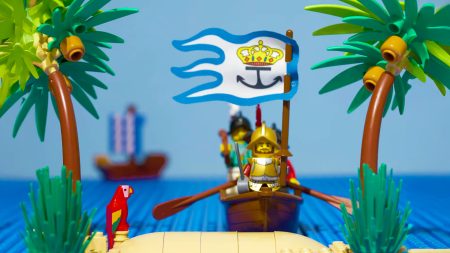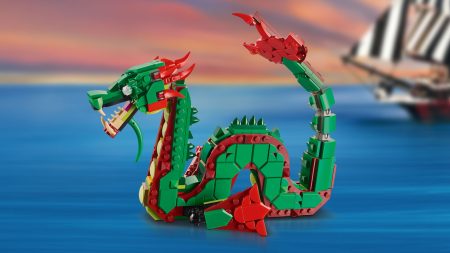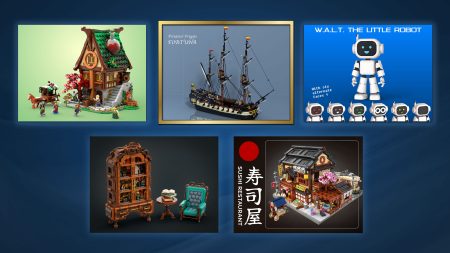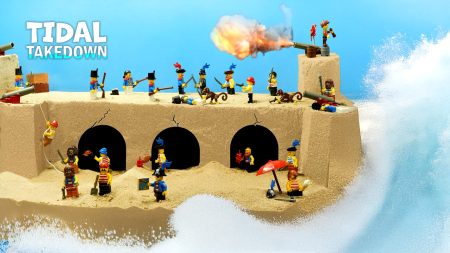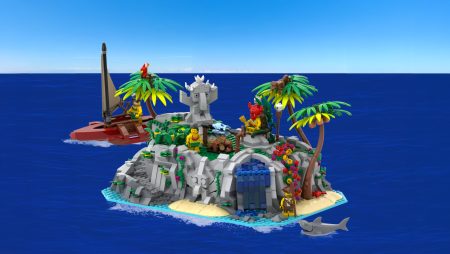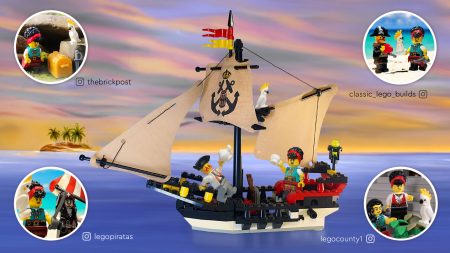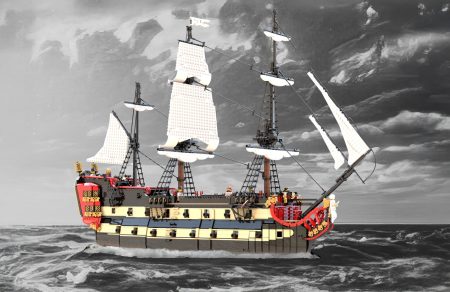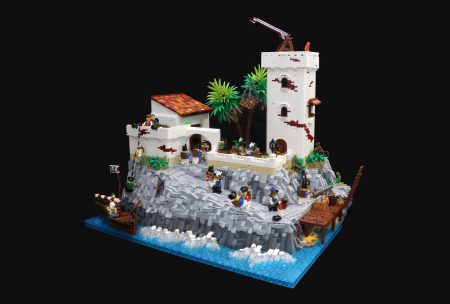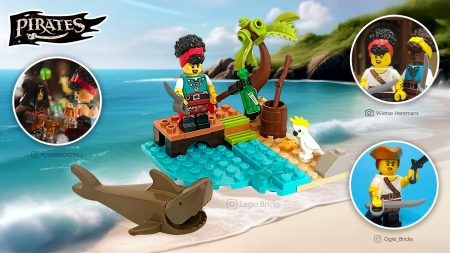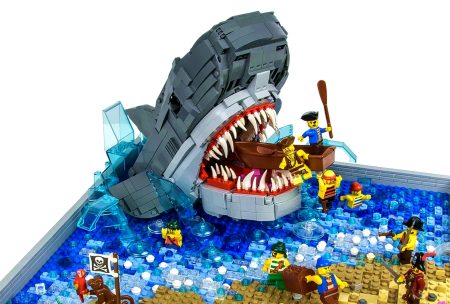Every time I have seen a “big miniatures” game done at a convention, lots of people have hung around to watch. So it’s a lot of fun to run this game LONG . . . essentially, it becomes a LARP. It can go on all day, or longer, if the convention wants it as a centerpiece. People can enter and leave as they wish; if you leave your ship in port, it’s safe and you can come back to it.
The players — up to 20 at once, perhaps more — are all pirate captains. It’s a game of plotting and roleplaying, as they move their ships around the tropical waters to seek weak prey, capture it, spend the money on debauchery and bigger ships, intrigue among themselves, and so on. A computer assistant will make the GM’s job easier, when I get around to it.
But when a victim shows fight, or when the Royal Navy catches up with a pirate, or when pirates attack each other, then it’s hands and knees on the floor to wargame the battle with toy ships. Only those players actually involved in the combat need to stop their “campaign” moves; the rest keep playing.
THE REFEREES
The referees are in charge of the game. They should be in costume, too, if at all possible! It’s a good idea not to schedule any referee for more than a four-hour shift at a time. Referees’ clipboards should be a different color to make them easier to spot, and printing out referee sheets on a different color paper is also a good idea.
Head Referee: The last word. Settles disputes. Assigns bonus points for costuming, and extra Reputation for roleplaying. May hold any of the other referee roles, or just rove around the game going “Arrrrrrrr!”
Sutler: Buys and sells goods, from a single oar to a man’o’war. Sets up new players with their beginning ships and crews, and sends them to the Map Referee to get into the game. Acts as banker for players who want to leave their money with him, and figures their loss or interest when they return. If there is a Council, the Sutler also keeps track of time, and of transactions during each hour, and splits 25% of that amount between the outgoing Councilors.
Map Referee: Controls the “map” — that is, the floor with the ships and islands on it. Makes sure that players do their moves correctly. Determines random encounters, and passes appropriate information to the Combat Referees so they can set up the fight. Records location of hidden islands.
Combat Referees: Usually there will be need for at least two. They set up and administer combats, when they occur. Teach the combat system as needed; roleplay a combat-wise First Mate to advise new captains. Control enemy ships or islands that show fight (or recruit currently inactive players to control them). Hand over the loot when a prize is taken.
Double-Sized Game
For a very big game, there could be two maps: one would represent the Caribbean, and the other would show the Madagascar area, with its own Council and its own Sutler. Travel between the two maps would be possible but slow, and specialty goods from one side of the Atlantic would bring more on the other side! There might even be room for (gasp) HONEST trade.
PLAYER SETUP
Players may join the game at any time.
Each player starts with a Pirate Captain figure (whom he should name), a small ship (which he should also name), and a crew.
The Head Referee will give a bonus for piratical costuming; he may invite the other referees, or the players, to vote on how much bonus you should get, and he may be influenced by appropriate piratical bribes. The bonus will take the form of card draws from the Non-Combat Specials List. These are things which will help your career without giving you an unfair advantage over your fellow pirates in direct combat.
New players start by visiting the Head Referee to see if they get any costuming bonuses. They then visit the Sutler and get a Setup Sheet to outfit themselves. When they are outfitted, they can embark on their careers.
Players Start With Their Choice Of:
(a) A cutter, a cannon, a boat with two pairs of oars, 10 men and 15 bonus points, or
(b) A brig, 15 men and 10 bonus points.
The bonus points let them buy extra weapons (crewmen come with a pistol, and those without a hook-hand also have a cutlass), extra crew, or special abilities for the crew. Points cannot be saved. All further acquisitions will require gold; go steal some.
- Extra pirates: 1 point each, which includes the pirate’s own weapon(s).
- Special abilities (see below): Each costs 3 points, over and above the cost of the pirate it is added to.
- Muskets: 2 for one point.
MANNING THE FLEET
Captain:
See above for the Captain’s abilities. Captains also have a Reputation, which normally starts at zero. See below.
Regular Crew:
You may have as many ordinary pirates as you can hire and stand up (or sit down, or grab the rigging) on your ship. Warning: any pirate who falls off is overboard, and must swim back or feed the sharks.
Special Crew:
You may buy these abilities when you first start, and add them to any pirate you own. Later, if you are lucky, you may be able to hire more special crewmen.
Special crew are never hit in combat, unless there are no ordinary seamen to hit. Pirates may have more than one special ability, but may not have more than one nationality. So you can have a Completely Loyal Polish Gunner for 7 points, or even a Completely Loyal Polish Gunner who is an Old Salt and a Navigator for 13 points, but you can’t have a pirate who gets both +1 to damage control and +2 with cutlass, because that would require him to be both Scottish and French.
Each special crewman is represented by a card. Indicate which figures represent special crew by marking on the figure (on the back of the legs, so it can be erased easily) and on the cards, using a grease pencil.
Captains may be given special abilities. All captains are already navigators and have a +1 with cannon and +2 with all other weapons. Extra weapon bonuses from a nationality DO add to this; a French captain would have +4 with a cutlass. Zut alors, me hearties!
Navigator: Can read maps, record the positions of islands, and so on. Does not get lost. Captains have this ability automatically.
French Swashbuckler: +2 with cutlass, and -2 to any sword attack against him.
Polish Gunner: +1 to hit for the cannon which he serves.
German Mercenary: +2 with two-handed axes and halberds, and -2 to any sword or axe attack against him.
Dutch Helmsman: +2″ to ship movement any turn he is at the helm (that is, handling the ship rather than fighting or doing anything else). This is not an initiative bonus, though.
American Rifleman: +2 with a musket (because if he has it, it’s a rifle).
Scottish Engineer: Automatically succeeds, by himself, in any damage control effort (that is, he is the equivalent of a 6-man damage control party).
British Deserter: This pirate fled the rigid discipline of the Royal Navy. He is familiar with all the British ships that are normally found in these waters, and knows his way around the Navy bases. The referee will use him as a conduit for information at appropriate times.
Spanish Deserter: This pirate escaped from the Spanish treasure fleet. He knows about the treasure ships and their captains; the referee will use him as a conduit for information at appropriate times.
Indian Archer: +1 with bow and arrow (nobody else except Islanders can use bow and arrow).
Islander: This native decided to join the pirates and see the world. +1 with spear, and can use bow and arrow (treat as a musket).
Natives can swim like fish, at 4″ a turn (other pirates can barely dog-paddle). If they fall overboard, they don’t drop their weapons, and they automatically make it back to the ship. If you have an Islander, you have a chance of recovering sunken treasure, rescuing men in the water, and so on (roleplay it). The Islander in the picture lured the gators away from the island and reached the ship safely . . .
Completely Loyal Henchman: You saved this pirate’s life, and he will never play you false. If you place him in charge of a prize crew, you may control that ship’s actions as well as those of your own ship, wherever it goes. If you leave him in charge of an island base, the men there won’t rebel or steal your goods.
Old Salt: Knows what the next change in wind speed and direction will be, though not when. It’s up to the Old Salt’s player to remember to ask the referee . . .
Expert Captain: This applies only to the Captain, and cannot be bought. It gives +1 on initiative. The way for a Captain to be recognized as “expert” is to defeat a ship of at least twice his Class, or to perform some equivalent feat (this will also aid Reputation, of course). It’s entirely a GM decision.
Non-Combat Specials
These are special bonuses that can be used as rewards for good costuming, etc., without unbalancing combat.
Charmed Life: Applies only to captains. You cannot die at sea, and the only way that you can die on land is of old age, starvation and exposure, or (more likely) by hanging. The pirate law forbids pirates from hanging each other, so if you fall into the hands of foes and they discover they can’t kill you, they will probably have to maroon you or let you go. Of course, non-pirate foes are free to hang you.
Treasure Map: You have a piece of a treasure map. Note that some maps are better than others . . . and you always have to get at least two pieces in order to use a map.
Fearsome Reputation: You start the game with a +1 Reputation!
Island: You know the location of an island with food, fresh water, etc., in a useful place. You may share this with other pirates if you like, and they have a normal chance of finding it if they are in that area.
Magic Items:
- Scroll that drives away “toothy monsters.”
- Scroll that raises a wind or calms one (maybe just for your own ship). This could be used in combat, though, to catch a foe or escape.
TURN SEQUENCING
Each “daily” turn, the GM rolls for weather. The players then write down their moves and execute them all at once (no initiative). A “collision,” or coming within 6″ of each other, or being within 6″ of the same island and in line of sight, means they see each other.
The GM then rolls for encounters; if there is an encounter, he tells each player what he sees. Time for role-playing (and common sense on the GM’s part); if the pirate ship is clearly superior, the victim may just give up right there, without recourse to combat. Of course, if combat is required, the GM will quickly brief a combat referee on what is to happen, and the player repairs to the floor with his ship. See below.
Or one ship or the other may choose to flee, and the other must decide whether to give pursuit.
If a pursuit occurs, roll D10 for number of hours of clear daylight. To determine whether the chase can be brought to bay, take the difference in their speeds, in the direction the chase chooses to go, and subtract it from 10. So if one ship has a speed of 12 and the other 8, the difference is 4. 10-4 is 6; it will take 6 hours. If the pursuer catches up, go to combat, and start with the ships 20″ apart.
If one ship escapes in the dark, the GM will roleplay with the player to see if the pursuing ship outguesses its prey and starts the next day in sight of her!
It’s also possible, of course, that land will be nearby, and the chase will make for a safe port. The GM can judge this as need be.
Note that players can see each others’ positions, and hear a lot about their rivals are doing. This represents the spread of rumor among pirates, which is somewhat faster than light.
COMBAT
Combat is conducted by getting down on the floor with the toy ships. It uses the combat rules, described above, and is moderated by a separate GM or team of GMs.
Combat turns are the same turns as “strategic” turns. So the same 10- or 15-minute period can represent a day for players out of combat, and a few minutes for players in combat. It works; deal with it.
When combat is over, the surviving players resume normal play.
Making Up Lost Turns
Combat may cause a ship to miss several “daily” turns. This appears not to be a problem.
Sailing Into Combat
You may ask “What if there is a combat going on, and I want to join it, or if I accidentally sail into it?”
This doesn’t happen. Combats are brief, and strategic turns represent a day. There are two ways to solve this:
(1) Move all combatant ships to another area and let them fight it out there.
(2) Let other ships in the area, not involved in the original fight, move right through the combat. If necessary, they get a lucky following wind which speeds them just far enough on their way to clear the combat zone.
Avoiding Adventure
If a player needs to leave for a while (for dinner, for instance), he can simply leave his ship at Port Royale or any other friendly port. It will be there when he gets back.
The GM may also allow a ship at sea to go “on autopilot,” straight to the nearest port, if the player has to leave for a while (or vanishes and cannot be found).
LOOT
Loot may be gained several ways, but the likeliest is by piracy on the high seas. Close with another ship; force her to surrender, or batter her into helplessness; go aboard, and see what you found.
The GM will draw cargo slips for you; normally there will be 1 for a Class 1 cargo ship, 2 for a Class 2 and so on. These will go to the Combat Referee, not straight to you. You have to take the ship before you can see its loot (unless the referee decides you can see something when you get close).
Treasure is represented by chests and barrels. These must be stored aboard your own ship; what you can’t fit aboard must be left behind, unless you keep the ship too. Note that some cargoes can’t be transshipped; if you find cattle, for instance, you must take the whole ship or leave the beef.
You will also be given the slips showing what you have found, unless the treasure is something that can be represented by actual items in a chest (e.g., gold and jewels).
You may trade treasure with other pirates or with NPCs . . . or you may carry it back to a port and sell it to the Sutler. To sell treasure, give the Sutler the card(s) showing what you have, and turn in enough chests and barrels to match. If you don’t have enough chests and barrels to match the card(s), the Sutler will assume that you kept the most valuable ones (say, silks and silver) and abandoned the less valuable (say, gunpowder and molasses).
The Sutler will also buy weapons, cannon, ships, and so on . . . usually for ALMOST as much as he would sell them for.
The Sutler will pay in gold; he does not do straight barters. He may or may not post his prices beforehand, and prices may vary from time to time.
Reality check on treasure: A historical pound of silver was worth $1,000. A pound of gold was worth $32,000. A chest suitable for 100 lbs. of treasure would itself weigh 40 lbs.
Prizes
Often, more valuable than anything on a captured ship is the ship itself. Historically, pirates often took over a captured ship and gave their old ship to the crew they’d just dispossessed! But if the crew is big enough, or a friendly port is close enough, a pirate crew can keep control of both the old ship and the captured one, sailing back to sell their prize for whatever it will bring.
Again, the Sutler will pay in gold.
PORTS
There may be several island ports. Some are friendly to pirates, some are neutral, some are hostile. At the beginning of the game, pirates start at Port Royale, a friendly port. Any shipping near such a port will be under some pirate’s protection, if not owned by a rich pirate or ex-pirate. It’s easy to sell loot and recruit men here.
Hostile ports: British or Spanish bases. Don’t even think about making port here. Think you can take a prize nearby? Good luck.
Neutral ports: Where there are merchants there is wealth to be had. However, if piracy near a port has not been too promiscuous and bloody, a smooth-talking pirate can refit there as though it were a friendly port, and even recruit men.
When a ship comes into port, roleplay appropriately.
ISLANDS
If you find a pleasant island, with fresh water and trees, you may choose to stop off there to give the crew liberty, work on your ship, and so on. Or, of course, bury some treasure. You may find other uses for an island. Roleplay them and see what happens.
GOLD
Doubloons! Arrrrrr!
Since this is a roleplaying game, players have some leeway to set their own goals. But you can never have too much gold.
The Sutler at any port will accept gold in payment for anything from a cutlass to a full-rigged man o’war, assuming he has one handy. Gold is also used to hire crewmen, and to pay for their debauches after a successful voyage. And it makes a good medium of exchange between players (though of course you can swap cargo, crew, and even ships if you choose).
Spending Gold
This price list covers all “routine” purchases and expenses. If you want something not on this list, roleplay it with the Sutler. If you are convincing enough, generous enough, or amusing enough, something may be arranged.
Cutlass: 1
Pistol: 2
Musket: 3
2-handed ax: 2
Treasure map: Varies!
Digging tool: 1
Ship’s boat: 10
Sail and mast for ship’s boat: 5
Oars for ship’s boat: 2/pair
Cannon: 100
Things you can’t buy include chests and barrels (because they are used as counters to represent loot); pirates (you hire them, but you have to keep paying them or they leave); and ammunition (because the game ignores ammo).
Buying and Selling Ships
This is a special case. No two ships are alike. The prices below represent a general guideline. The Sutler will take into account the condition of the ship (damaged prizes are worth less), the current demand for that type of vessel, the reputation of the pirate he is dealing with, the bribes he is offered, and perhaps other things as well. These are prices for a ship without guns.
- Class 1: Cutter (small, fast and nimble; vulnerable in combat): 300
- Class 2:
- Regular ship with no center section (slow, cargo vessel): 550
- Brig (smaller but faster): 450
- Class 3:
- Wide ship with no center sections (slow, large cargo vessel): 800
- Regular ship with 1 center section (cargo vessel or warship): 900
- Class 4:
- Wide ship with 1 center section (cargo vessel or warship): 1,200
- Regular ship with 2 center sections (fast, good warship): 1,400
- Class 5 – Regular ship with 3 center sections (schooner, very fast): 1,700. Note: Right now we have no Class 5 models available.
- Class 6 – Wide ship with 2 center sections (fast): 2,200
- Class 7 – Wide ship with 3 center sections (very fast): 2,700
- Class 8 – Wide ship with 4 center sections (huge and very fast): 3,500 Note: Right now we have no Class 8 models available.
POST-VOYAGE EXPENSES
Debauchery
When you reach a “civilized” port, the crew will expect to be paid in gold, especially if the voyage was a success. The length of the voyage is not important; pirates expect to be paid at the rate of one good drunk per voyage. You MUST pay your crew, even if it means selling your ship! If you cannot pay your crew, they will elect a new captain, and you’re out of the game . . .
You may, if you choose, “fire” some of your pirates AFTER you pay them, but not before.
If you captured or looted no ships, or if your ship was sunk and you made your way back to port without it, you must pay 3 to each member of the crew.
If you captured or looted one ship, pay 6 to each member of the crew.
If you captured or looted two or more ships, pay 10 to each crewman.
Recruitment
Your crew will (probably) come back after their revels, but you might want more. If you want to hire more crewmen, you may now try to do so. The table below will give the result of your attempt. Roll 3 dice, and modify the result as follows:
Add your Reputation, and add another +2 if in a friendly port.
Add the number of prizes you took on your last voyage (up to 3).
- 3 – Two crewmen deserted, taking their personal weapons, and stealing a boat if the ship had any. You may roll again to see if you can recruit anyone.
- 4 – A crewman deserted, taking his personal weapons. You may roll again to see if you can recruit anyone.
- 5-8 – No recruits are available.
- 9 – Three random pirates.
- 10 – Five random pirates.
- 11-12 – Seven random pirates.
- 13 – Ten random pirates.
- 14-15 – One of your existing crewmen (pick which one) has become Completely Loyal to you. You may roll again to see if you can recruit anyone else.
- 16-18 – A seaman with a special ability (GM chooses randomly) is available. You may roll again to see if you can recruit anyone else.
The Sutler reaches into the box to see who is available. An able-bodied seaman, regardless of special talents, can be hired for 3 gold pieces. A seaman with a peg leg, or a hook hand, or both, can be hired for 2. Crew is not always available; you take what you can get.
A crewman comes with a pistol and a cutlass (hook-handed seamen come with a pistol, because they have a built-in cutlass). If he quits your service, you have to let him take with him the weapon(s) that he brought.
Ship Repairs
Your jolly tars will be able to repair a lot of damage to your ship, but when you come back to port, you should pay the shipyard to check everything out. If you don’t do so, the GM will determine this by rolling on a table which is NOT available to the players. You may get lucky . . . or some of the repairs may be faulty, and come undone at exactly the wrong moment.
(Exception: If you spend a week on a wooded island, your crew can make all the necessary repairs, all safe and shipshape, at no cost to you.)
Rigging: You need pay nothing to repair your rigging unless it was reduced to 0 at some point during your voyage. In that case, pay (Class x 10).
Hull: Pay 3 for every hull hit you took, regardless of whether you did Damage Control. If you choose not to do so, your ship may have permanent hidden damage.
Steering: Pay 10 for every Steering hit you took. If you choose not to do so, your ship may have permanent hidden damage.
Safeguarding Your Treasure
The problem with gold is hanging onto it until you are ready to spend it. Players may NOT just hide it in their pockets. You may:
- Put it in a treasure chest, or chests, and keep it on board ship. It is perfectly safe there unless something happens to your ship. Incidentally, it takes two men to carry a treasure chest, at a movement of 3″ per turn, and it takes the place of two men if carried in a boat.
- Bury it on an island. It is fairly safe there. A treasure map or treasure rumor will go into circulation… and, of course, you will have to go back to get it before you spend it.
- Invest it with a banker in port. The Sutler will roll 2 dice every time you return to that port (no more than once a week), adding your Reputation (and perhaps other factors) to your die roll. Subtract 1 from your roll in a Neutral port.
- A natural 2 — The banker ran off with your money. All reputation bonuses are ignored. You’re hosed.
- 3-4 — You get back only 25%.
- 5 — You get back 50%.
- 6 — You get back 75%.
- 7-9 — You get back all your money.
- 10 — You make a profit of 10%.
- 11 — You make a profit of 25%.
- 12 or more — A profit of 50%!
- Give it to another player to keep, and risk both his luck and his honesty.
- Spend every penny as soon as you get it. This is very period.
Reputation
Every captain starts off with a zero (that is, average) reputation, unless he gets a reputation bonus at the start of the game for a great costume!
As the game goes on, you can gain (or lose) Reputation. If there is a table for everyone to sit at when not running their ship, handle it like this: Once an hour, by the clock, the seating is rearranged, with the best Reputations moving to the head of the table. Ties go to the player who has had that Reputation longest. New players always enter at the foot of the table; yes, they are below older players with negative reputations, until the next time the ship’s bell rings.
The four players closest to the head of the table constitute the Council of Tortuga. At the end of their hour in office, they split 25% of everything paid to the Sutler during that time.
- It increases your chance of recruiting new crew (see above).
- Money invested with a banker is safer when you have a good Reputation.
- The referee will take your Reputation into account when determining the reaction of NPCs.
If there is a single pirate with the highest Reputation, he may style himself the King of the Pirates, for whatever good it does him. Other advantages to good Reputation:
Gaining Reputation
Every prize you capture gives you +1 Reputation, unlesss your Reputation when you capture it is greater than the Class of the prize. In other words, if you have Reputation 3, you get no Reputation bonus for a prize of Class 2 or below.
Sinking a Royal Navy ship, or any other fully armed vessel, is as good as capturing it for Reputation purposes. Sinking a ship that carries less than its full complement of cannon will count as if it were of the Class equal to its number of guns.
Spending freely in port, buying rum for everyone in sight, is a sure way to win esteem. You must spend 100 times your current Reputation, in a single debauch, to earn +1 Reputation. The minimum here is 100, for those unlucky captains who have zero or negative Reputation.
While you have the biggest pirate ship in play, you get +1 to effective Reputation; you can’t lose this “virtual” Reputation point. The referee will award extra Reputation for anything else that deserves it, especially if it is well roleplayed.
Losing Reputation
Every hour, after seating is rearranged, the highest Reputations are reduced. Any reputation of 6 or more is reduced by 2. Reputations of 2 through 5 are reduced by 1. (So what have you done LATELY?)
If you return from a voyage without any heroic deeds at all, your reputation goes down by 1. Taking a prize or sinking an armed foe is heroic, of course, but you can always try to make something else you did SOUND heroic . . .
Having a ship sunk under you will decrease your Reputation by 2, unless you also sunk your antagonist (in which case you do earn Reputation for sinking him).
Running away from a fight, betraying a comrade, murdering your own crew, and similar actions MAY decrease your Reputation . . . depending on who notices, and how you carry them off.
ROLEPLAYING
This is a roleplaying game. The GMs will take the parts of various Non-Pirate Characters, and perhaps the occasional pirate as well. Players who interact with gusto and a sense of (cinematic) realism will be rewarded, and even if they die, it will be a memorable death. Boring players will probably get boring results, and have no one to blame but themselves. You have been warned, matey.
THE END
Where to now?
- Continue to Hidden Damage Tables
- Return to the Evil Stevie’s Pirate Game page
- Discuss the game in the LEGO Pirates Forum
- Official Website Steve Jackson’s Home Page
These rules are not licensed or approved by The LEGO Group.
Copyright 1998, 1999, 2000, 2003, 2010, 2011 and used with Steve Jackson’s permission.






